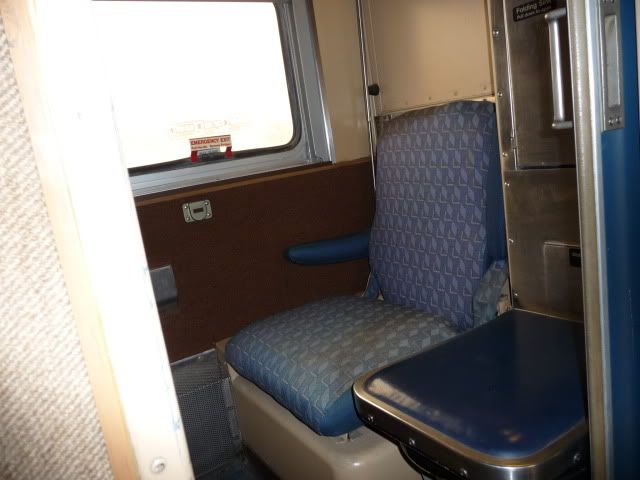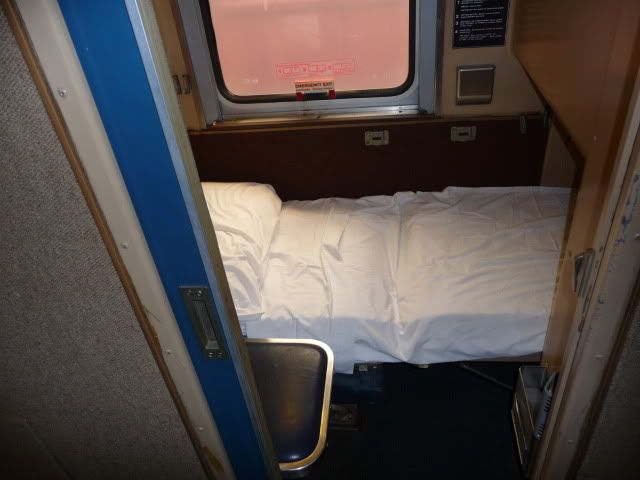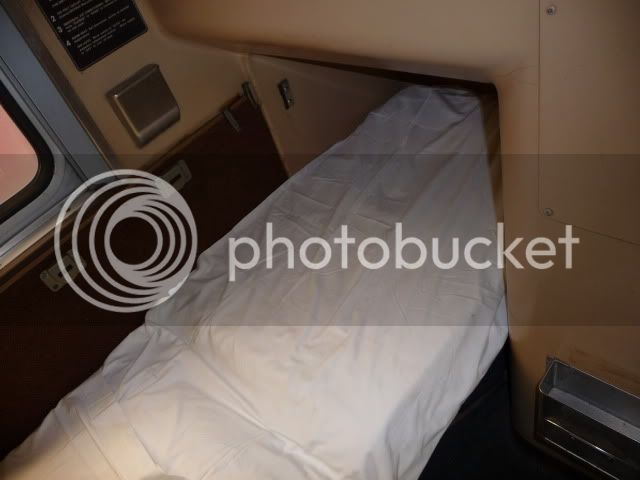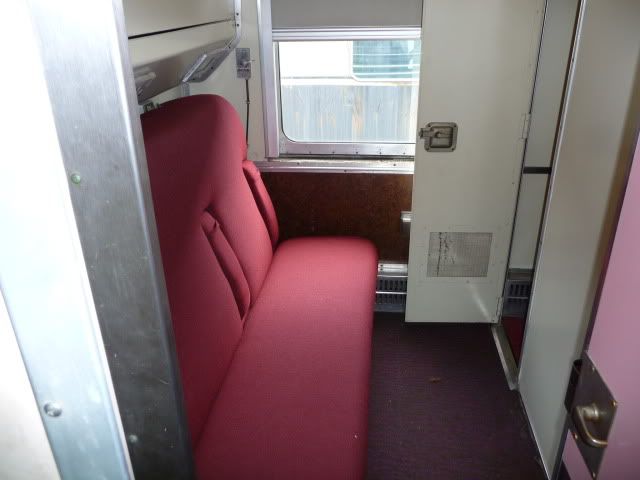On our CL trip to Chicago last week, we had a chance to drive up to Union IL to the Illinois Railway Museum. Its the largest museum of its kind and their collection is amazing. We were there on post office day where they were running a train (that you could ride in) with a railway post office car (that you could also enter) . All day they ran trains that picked up mail bags "on the fly" in front of the station. It was interesting seeing a train go by with a hook that would snare the mailbag at 30 mph. There days mail no longer travels by train but it was fun hearing all of the stories told by the men who once worked the mail cars. One guy told me that in snowy weather they sometimes worked 29 hours shifts.
Getting back to the subject of this post; we are relatively new to train sleeper travel. The only sleepers that we have ever been on are on Amtrak trains. At the museum we had the opportunity to explore just about every type of sleeper imaginable. The IRM has them all. I won't comment on all of them but a few caught my eye. These were all on streamliners (lightweight cars) but the section was on a heavyweight car
The first one was the pullman sleeper section. These were the coach type cars that converted into sleepers in the evening. Two facing seats that could be folded down to form a lower berth with an upper berth that folded down from above. Partititions separated the sections but a curtain was the only "door" for privacy. There was no place to put your overnight bag or slippers and I just wondered what happened when the person on the top had to take a nightime bathroom break. He had to open the one curtain that covered the upper and lower berths and the guy on the bottom got exposed. No privacy here but the accomodations were inexpensive and the beds had a thick matress.
The second one that caught my interest was the roomette. A chair with a potty on the side and fold down sink during the day and a single bed during the night that actually covered the toilet so there was no access at night. It looked like a Viewliner roomette but was only made for one person. Very similar to todays roomette private and with a locking door but for one
Next up was the bedroom. Very similar to todays Amtrak bedroom but with only with the sofa during the day and no easy chair. At night you had the standard upper and lower berths. It had a bathroom but no shower. Actually we didn't see a shower on any of the cars that we toured so people must have had different sanitary habits in those days. We also saw double bedrooms where a partition could be removed to make up a room for four, similar to the principle of todays bedrooms where they can be opened up for a bigger space.
The most unusual design was the Duplex roomette. Overlapping rooms on two levels on both sides of the car staggered one high and one low. A very small space with a chair during the day, a toilet fold down sink and a bed that pulled out from under the room in front of you. The lower part of your body slept in a "tunnel". It was a tight (but private) space for one and an amazing 28 of these lined both sides of the car. Again the toilets were only accessible during the day. Changing the sheets was probably not easy! I am told that the duplex design was also offered in a single room variety where the room had a sofa and was wider with rooms on only one side of the sleeper car.
There are many more sleepers that we saw at the museum but they are too numerous to mention.
Analysis. While the plush fabrics, fancy curtains, design elegance and long food menus from the golden days are gone; the design of todays Amtrak sleepers seem more practical and a bit more spacious than the designs of the past. Plus if you book a bedroom you have the shower available. I don't believe that todays sleeper passengers are being shortchanged. We would like to see better interior decor being used but at least we still have long distance trains in the 21st century.
Again the pics will be coming later today.
Getting back to the subject of this post; we are relatively new to train sleeper travel. The only sleepers that we have ever been on are on Amtrak trains. At the museum we had the opportunity to explore just about every type of sleeper imaginable. The IRM has them all. I won't comment on all of them but a few caught my eye. These were all on streamliners (lightweight cars) but the section was on a heavyweight car
The first one was the pullman sleeper section. These were the coach type cars that converted into sleepers in the evening. Two facing seats that could be folded down to form a lower berth with an upper berth that folded down from above. Partititions separated the sections but a curtain was the only "door" for privacy. There was no place to put your overnight bag or slippers and I just wondered what happened when the person on the top had to take a nightime bathroom break. He had to open the one curtain that covered the upper and lower berths and the guy on the bottom got exposed. No privacy here but the accomodations were inexpensive and the beds had a thick matress.
The second one that caught my interest was the roomette. A chair with a potty on the side and fold down sink during the day and a single bed during the night that actually covered the toilet so there was no access at night. It looked like a Viewliner roomette but was only made for one person. Very similar to todays roomette private and with a locking door but for one
Next up was the bedroom. Very similar to todays Amtrak bedroom but with only with the sofa during the day and no easy chair. At night you had the standard upper and lower berths. It had a bathroom but no shower. Actually we didn't see a shower on any of the cars that we toured so people must have had different sanitary habits in those days. We also saw double bedrooms where a partition could be removed to make up a room for four, similar to the principle of todays bedrooms where they can be opened up for a bigger space.
The most unusual design was the Duplex roomette. Overlapping rooms on two levels on both sides of the car staggered one high and one low. A very small space with a chair during the day, a toilet fold down sink and a bed that pulled out from under the room in front of you. The lower part of your body slept in a "tunnel". It was a tight (but private) space for one and an amazing 28 of these lined both sides of the car. Again the toilets were only accessible during the day. Changing the sheets was probably not easy! I am told that the duplex design was also offered in a single room variety where the room had a sofa and was wider with rooms on only one side of the sleeper car.
There are many more sleepers that we saw at the museum but they are too numerous to mention.
Analysis. While the plush fabrics, fancy curtains, design elegance and long food menus from the golden days are gone; the design of todays Amtrak sleepers seem more practical and a bit more spacious than the designs of the past. Plus if you book a bedroom you have the shower available. I don't believe that todays sleeper passengers are being shortchanged. We would like to see better interior decor being used but at least we still have long distance trains in the 21st century.
Again the pics will be coming later today.
Last edited by a moderator:








